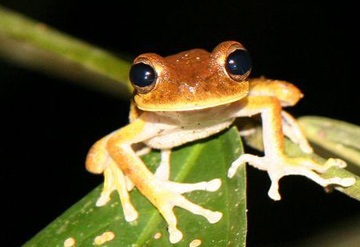 Bat Deaths in NY, Vt. Baffle Experts
Bat Deaths in NY, Vt. Baffle Experts
The Associated Press - ap.google.com
30 Jan 2008
M Hill
Photo courtesy of Nature.com
Area: New York, Vermont United States
Bats are dying off by the thousands as they hibernate in caves and mines around New York and Vermont, sending researchers scrambling to find the cause of mysterious condition dubbed "white nose syndrome." The ailment — named for the white circle of fungus found around the noses of affected bats — was first noticed last January in four caves west of Albany. It has now spread to eight hibernation sites in the state and another in Vermont. Alan Hicks, a bat specialist with New York's Department of Environmental Conservation, called the quick-spreading disorder the "gravest threat" to bats he had ever seen. Up to 11,000 bats were found dead last winter and many more are showing signs illness this winter.
One hard-hit cave went from more than 15,000 bats two years ago to 1,500 now, he said. "We do not know what the cause is and we do not know how it was spread, either from cave to cave, or bat to bat," said Hicks. "You have this potential for this huge spread." The white fungus ring around bats' noses is a symptom, but not necessarily the cause. For some unknown reason, the bats deplete their fat reserves and die months before they would normally emerge from hibernation.
Suspected bird flu shuts Hong Kong park's aviaries
Reuters - www.reuters.com
31 Jan 2008
Area: Hong Kong China
A Hong Kong theme park is to shut its aviaries for three weeks following the discovery of a wild heron suspected of dying from bird flu. The bird was found on Monday in a remote area of Ocean Park, on the south coast of Hong Kong Island. "As a precautionary measure, the walk-in aviaries in Ocean Park will be temporarily closed to visitors for 21 days starting tomorrow," said a spokesperson with Hong Kong's Agriculture, Fisheries and Conservation Department. Ocean Park, a conservation-focused theme park with pandas, dolphins, birds and rollercoasters, attracted nearly 5 million visitors last year, proving more popular than the struggling Hong Kong Disneyland.
Related News
>>>Dorset avian influenza epidemiology report published
>>>India sprays markets, roads to halt bird flu outbreak
>>>Police arrest trio for smuggling chickens
>>>Avian flu outbreak closes in on Kolkata
>>>'Bangladesh dumping dead poultry in no-man's land'
 The bovine TB challenge
The bovine TB challengeMinnesota Public Radio - minnesota.publicradio.org
31 Jan 2008
D Gunderson
Photo courtesy of State of Michigan
Area: Minnesota United States
Bovine tuberculosis could lead to more restrictions on Minnesota's cattle industry. State and federal officials along with several farm groups will discuss the ongoing disease outbreak. They're considering ways to minimize the economic damage to farmers and ranchers. When bovine tuberculosis showed up in a northern Minnesota cattle herd, state officials acted quickly to slaughter the herd and stop the disease. They believed it was an isolated case.
It's been nearly three years since that first case of bovine TB, and last week the disease was found in a ninth cattle herd. TB has also been found in 17 wild whitetail deer, including four killed last fall. "With every year that we continue to find infected herds and infected deer it becomes more of a challenge," says Minnesota State Veterinarian Bill Hartman. "We were hopeful we would be able to go up there and eliminate the infection from the cattle rapidly and do the same with the deer. Continuing to find herds this far into it is certainly not a good thing," Hartman says.
Related News
>>>Two TB-positive deer confirmed in Iosco
>>>Farmers prepare to test cattle after TB discovery
 New research refutes global warming's influence on amphibians' worst enemy
New research refutes global warming's influence on amphibians' worst enemyMongabay - news.mongabay.com
30 Jan 2008
M Erickson-Davis
There is no doubt that global warming is having a negative effect on amphibians, but it is yet unclear whether or not a direct causal relationship exists between global warming and the spread of a specific fungal epidemic wreaking havoc on amphibian populations worldwide. In 1998 a previously undescribed pathogenic fungus, Batrachochytrium dendrobatidis, belonging to the chytrid group of fungi, was reported independently in Panama and northern Queensland, Australia, where it was causing massive declines in local frog populations. Since then, it has become the dominant cause of amphibian declines and extinctions worldwide.
Research has been undertaken in effort to determine whether global warming is encouraging the disease to spread so quickly, or if instead, human global movements are mainly to blame. A study authored by a team headed by J. Alan Pounds in 2006 and published in the journal Nature reported that most fungal pathogen-linked extinctions of harlequin frogs in upland rainforests of South America occurred immediately after years during which those areas experienced higher than average temperatures, implicating global warming. However, new findings are challenging those views.
 Them dirty rats ain't so alike after all
Them dirty rats ain't so alike after allThe Age - www.theage.com.au
01 Feb 2008
CC Leung
Photo courtesy of Ken Aplin
While the rodent known as Rattus rattus is one of the greatest transmitters of human disease — and an agricultural pest — little has, until now, been known about its genetic make-up. But after sequencing the DNA of 165 black rats from 32 countries, a team of Australian and international scientists have discovered a surprisingly high level of genetic diversity. This led them to suggest there was not just one type of black rat, but possibly six distinct lineages that originated from different parts of Asia. "It means these different lineages have evolved independently for many hundreds of thousands of years, perhaps close to a million years since the original diversification," said Dr Ken Aplin, from CSIRO's Australian National Wildlife Collection.
 Swimmers' Sunscreen Killing Off Coral
Swimmers' Sunscreen Killing Off CoralNational Geographic News - news.nationalgeographic.com
29 Jan 2008
K Than
The sunscreen that you dutifully slather on before a swim on the beach may be protecting your body—but a new study finds that the chemicals are also killing coral reefs worldwide. Four commonly found sunscreen ingredients can awaken dormant viruses in the symbiotic algae called zooxanthellae that live inside reef-building coral species. The chemicals cause the viruses to replicate until their algae hosts explode, spilling viruses into the surrounding seawater, where they can infect neighboring coral communities. Zooxanthellae provide coral with food energy through photosynthesis and contribute to the organisms' vibrant color. Without them, the coral "bleaches"—turns white—and dies.
"The algae that live in the coral tissue and feed these animals explode or are just released by the tissue, thus leaving naked the skeleton of the coral," said study leader Roberto Danovaro of the Polytechnic University of Marche in Italy. The researchers estimate that 4,000 to 6,000 metric tons of sunscreen wash off swimmers annually in oceans worldwide, and that up to 10 percent of coral reefs are threatened by sunscreen-induced bleaching. The study appeared online in the journal Environmental Health Perspectives.
OTHER WILDLIFE DISEASE RELATED NEWS
 Delay in Decision on Protecting Polar Bears
Delay in Decision on Protecting Polar Bears- Tests confirm zoo anthrax
- Wildlife disaster as uncropped land is ploughed
- First rabies case in Guilford County in 2008
- Anglers confront whirling disease
- The rodent to ruin?
- Disease, weather take toll on deer harvest as hunting season ends
- Dead horse had rabies; Washington County farm quarantined
- Patrick Durkin column: Deer herds to pay for CWD panel's squabbling
WILDLIFE DISEASE RELATED PUBLICATIONS
Journal of Wildlife Management - January 2008
Volume 72, Issue 1
Prevalence of Coxiella burnetti infection in wild and farmed ungulates [online abstract only]
Veterinary Microbiology. 2008 Jan 01; 126 (1-3): 282-286
F Ruiz-Fons et al.





No comments:
Post a Comment